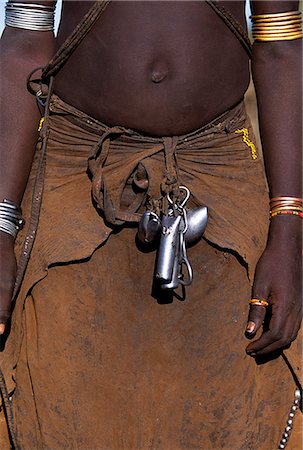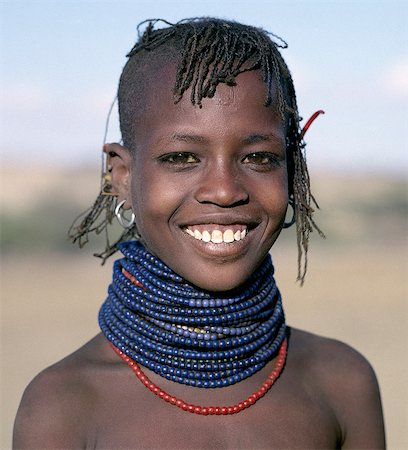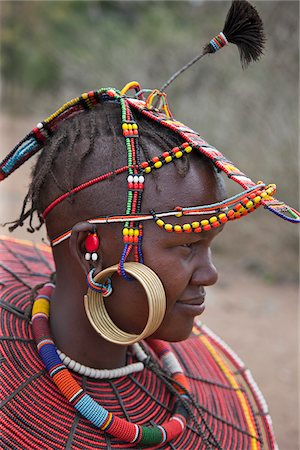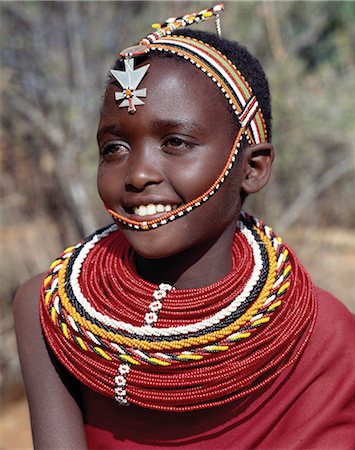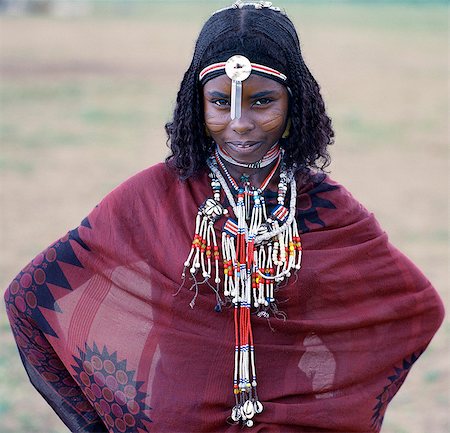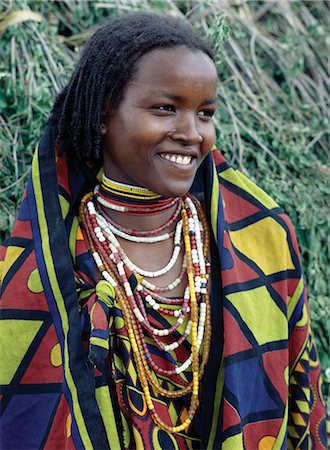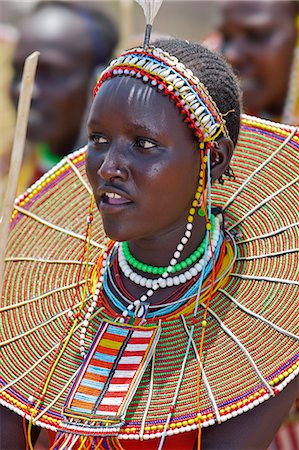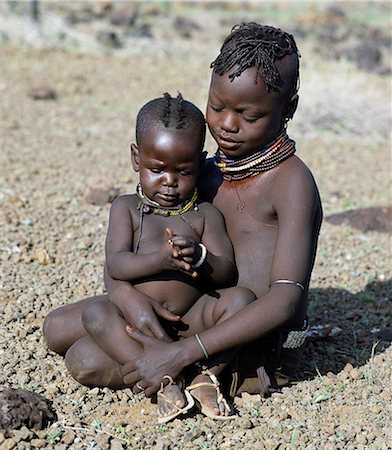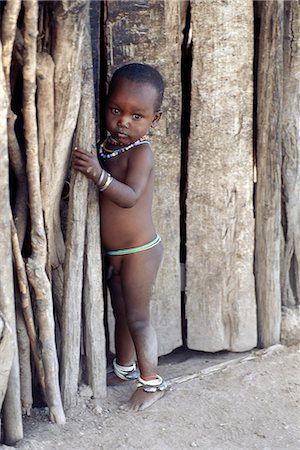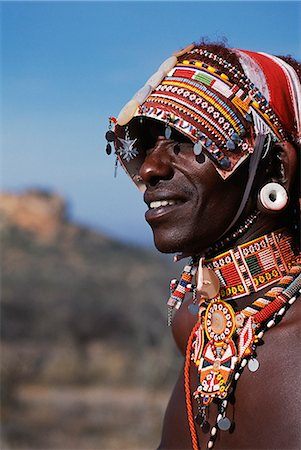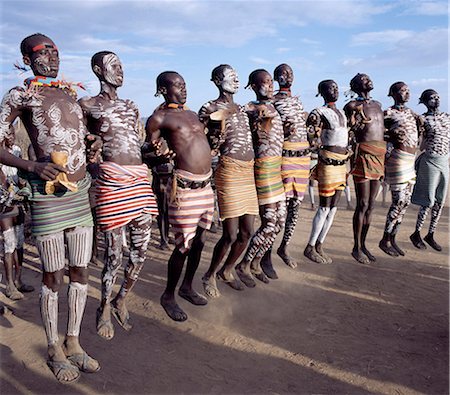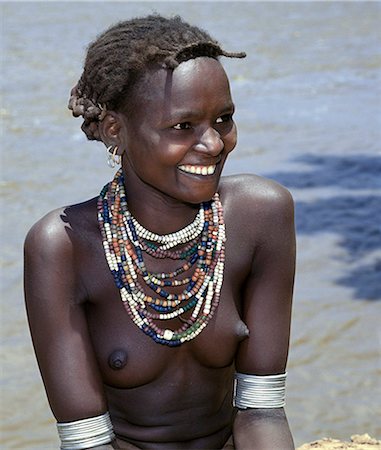-
A young Maasai girl wearing a wooden plug in her pierced ear to elongate the earlobe. It has been a tradition of the Maasai for both men and women to pierce their ears and elongate their lobes for decorative purposes. Her two lower incisors have been removed - a common practice that may have resulted from an outbreak of lockjaw a long time ago.
Rights-Managed
-
A young Dassanech girl wears a leather skirt,metal bracelets and amulets and layers of bead necklaces. Much the largest of the tribes in the Omo Valley numbering around 50,000,the Dassanech (also known as the Galeb,Changila or Merille) are Nilotic pastoralists and agriculturalists.
Rights-Managed
-
Maasai girls in all their finery and with bells tied round their legs wait at the entrance to a house before dancing with warriors.
Rights-Managed
-
A pretty young Turkana girl has already had the flesh below her lower lip pierced in readiness for a brass ornament after her marriage. The rims of her ears have also been pierced and the holes kept open with small wooden sticks.
Rights-Managed
-
Young Maasai girls decorate their faces with ochre and clay in preparation for a dance.
Rights-Managed
-
Maasai girls gather to celebrate a wedding. Their broad beaded necklaces with predominantly white glass beads mark then as Kisongo Maasai,the largest clan group of the tribe which lives either side of the Kenya-Tanzania border.
Rights-Managed
-
A Maasai warrior with his long braids and body coated with red ochre mixed with animal fat. He has put ochre dust round his eyes to enhance his appearance ready for a dance. The singular hairstyles of Maasai warriors sets them apart from other members of their society.
Rights-Managed
-
A Maasai warrior blows a trumpet fashioned from the horn of a Greater Kudu. The strap is decorated with cowrie shells. Kudu-horn trumpets are only sounded to call men to arms or on ceremonial occasions.
Rights-Managed
-
A young Karo girl in the doorway of her hut in the village of Duss. A small Omotic tribe related to the Hamar,who live along the banks of the Omo River in southwestern Ethiopia,the Karo are renowned for their elaborate body painting using white chalk,crushed rock and other natural pigments.
Rights-Managed
-
When a Turkana woman gives birth,four goats will be slaughtered in a twenty-four-hour period to celebrate the occasion. The skin of the first goat will be made into a pouch for carrying the baby on its mother's back. The small wooden balls on the back of this pouch are charms to ward off evil spirits. The baby is wearing a bracelet of ostrich eggshell beads.
Rights-Managed
-
A young Maasai girl wears face paint and numerous beaded ornaments in preparation for a dance with warriors.
Rights-Managed
-
A young Pokot girl in traditional attire. Girls wear leather skirts and capes made from home-tanned goatskins. Her broad necklaces are made from small segments of sedge grass. Her ears have already been pierced in four places,ready to insert the large brass earrings she will acquire after marriage.
Rights-Managed
-
A young married woman of the Pokot tribe. Her married status is denoted by her large brass earrings and broad beaded collars and necklaces that are smeared with animal fat to glisten in the sun.
Rights-Managed
-
Karo men excel in body art. They decorate their faces and torsos elaborately using local white chalk, pulverised rock and other natural pigments. Their braided hairstyles are typical of young men from the tribe.The Karo are a small tribe living in three main villages along the lower reaches of the Omo River in southwest Ethiopia.
Rights-Managed
-
A young Maasai girl wears a headband decorated with chains and cowrie shells that signifies her recent circumcision. Clitodectomy was commonly practiced by the Maasai but it is now gradually dying out.
Rights-Managed
-
A young Maasai girl keeps the holes in her pierced ears from closing with grass and rolled leaves. She will gradually stretch her earlobes by inserting progressively larger wooden plugs. By tradition,both Maasai men and women pierce and elongate their earlobes for decorative purposes.
Rights-Managed
-
A Maasai girl in traditional attire. The predominant white colour of her beadwork and the circular scar on her cheek denote that she is from the Kisongo section of the Maasai,the largest clan group,which lives either side of the border in Kenya and Tanzania.
Rights-Managed
-
Kenya, Samburu District. Young Samburu girl in traditional beaded necklaces.
Rights-Managed
-
A warrior of the Kisongo section of the Maasai with his long Ochred braids decorated with beaded ornaments. His broad armulet is typical of the Kisongo living in northern Tanzania where white is the preferred colour of their beadwork.
Rights-Managed
-
A young married Pokot woman wearing the traditional beaded ornaments of her tribe which denote her married status. The Pokot are pastoralists speaking a Southern Nilotic language.
Rights-Managed
-
A Turkana girl in all her finery. Among the Turkana,cicatrization is a common form of beautification. She wears a crucifix given to her by a missionary; they are popular ornaments despite not necessarily being associated with Christianity.
Rights-Managed
-
Portrait of Tuta by the Omo River, Dassanech Tribe, Rate Village, Omorate, Omo Valley, Ethiopia, Africa
Rights-Managed
-
Samburu girls are given strings of beads by their fathers when they are still young. As soon as they are old enough to have lovers from the warrior age-set,they regularly receive gifts from them. Over a period of years,their necklaces can smother them up to their necks. The metal cross-like ornament hanging from the girl's headband has no religious significance.
Rights-Managed
-
Kenya, Samburu District. A Samburu woman, wearing intricate beaded necklaces, leans against her mud hut towards the end of the day.
Rights-Managed
-
A young Datoga man tends his family's livestock on the plains east of Lake Manyara in Northern Tanzania.The Datoga (known to their Maasai neighbours as the Mang'ati and to the Iraqw as Babaraig) live in northern Tanzania and are primarily pastoralists..
Rights-Managed
-
A Turkana girl's necklaces are well-oiled with animal fat and glisten in the sun. The use of red ochre has been copied from their Samburu neighbours and is not widespread. Occasionally,a girl will put on so many necklaces that her vertebrae stretch and her neck muscles gradually weaken. The partially shaven head is typical of Turkana women and girls.
Rights-Managed
-
An Afar girl with braided hair has very noticeable scarification on her cheeks. Scarification is practiced in only a few sections of her tribe. Proud and fiercely independent,the nomadic Afar people live in the low-lying deserts of Eastern Ethiopia.
Rights-Managed
-
A pretty Borana girl at Mega in southern Ethiopia wears brightly coloured cotton cloth and numerous strings of beads. The pastoral Borana live either side of the southern Ethiopian/northern Kenya border and form a large and important group of the Oromo-speaking cluster of tribes.
Rights-Managed
-
An Afar girl has her attractive hairstyle embellished with buttons and beads,which is typical of the young girls of her tribe. Proud and fiercely independent,the nomadic Afar people live in the low-lying deserts of Eastern Ethiopia.
Rights-Managed
-
A young Turkana girl adorned with necklaces of a style the Southern Turkana prefer to wear.
Rights-Managed
-
A Samburu woman wearing a mporro necklace,which signifies her married status.These necklaces,once made of hair from giraffe tails,are now made from fibres of doum palm fronds (Hyphaene coriacea). The beads are mid-19th century Venetian glass beads,which were introduced to Samburuland by early hunters and traders.
Rights-Managed
-
A Turkana woman,typically wearing many layers of bead necklaces and a series of hooped earrings with an pair of leaf-shaped earrrings at the front,sits in the entrance to her hut.
Rights-Managed
-
A Maasai warrior in full regalia. He has stuck a porcupine quill in his beaded headband to add to his other decorations. His long,Ochred plaits have been drawn forward from the crown of his head and tied in three bunches.
Rights-Managed
-
A young Dassanech girl wears a beautiful array of beaded necklaces. Much the largest of the tribes in the Omo Valley numbering around 50,000,the Dassanech (also known as the Galeb,Changila or Merille) are Nilotic pastoralists and agriculturalists.
Rights-Managed
-
A Turkana woman sitting in the doorway of her hut. Her heavy mporro braided necklace identifies her as a married woman. Typical of her tribe,she wears many layers of bead necklaces and a beaded headband.
Rights-Managed
-
A Turkana girl with a large gourd-like container used as a receptacle for water or milk. In the absence of gourds,the Turkana carve their containers from soft wood,such as that from the common commiphora species,which thrives in semi-arid country.
Rights-Managed
-
Samburu girls are given strings of beads by their fathers when they are still young. As soon as they are old enough to have lovers from the warrior age set, they regularly receive gifts from them.Over a period of years, their necklaces can smother them up to their necks.
Rights-Managed
-
A Dassanech girl braids her sister's hair at her village in the Omo Delta. Much the largest of the tribes in the Omo Valley numbering around 50,000,the Dassanech (also known as the Galeb,Changila or Merille) and Nilotic pastoralists and agriculturalists.
Rights-Managed
-
Samburu girls are given strings of beads by their fathers when they are still young. As soon as they are old enough to have lovers from the warrior age-set,they regularly receive gifts from them. Over a period of years,their necklaces can smother them up to their necks. The metal cross-like ornament hanging from the girl's headband has no religious significance.
Rights-Managed
-
A Turkana man with a fine clay hairstyle,so typical of the southern Turkana. The black ostrich feather pompoms denote that the man belongs to the ng'imor (black) moiety of his tribe.
Rights-Managed
-
Two Turkana girls set off to fetch water from a nearby Waterhole. Their water containers are made of wood by the women of the tribe. Their 'V' shaped aprons are made of goatskin and have been edged with hundreds and hundreds of round discs fashioned out of ostrich eggshells.
Rights-Managed
-
A Samburu woman singing. The strings of black and white beads hanging from her ears signify that she has two grown-up sons who are warriors of the tribe. Note: the traditional horn snuff container hanging from her neck.
Rights-Managed
-
A young Pokot woman sings to celebrate the opening of a new pre primary school at Ngaini, a remote area of the Kerio Valley. Despite her youth, her jewellery denotes she is already married.
Rights-Managed
-
A young Afar girl at Filwoha in the Awash National Park. Filwoha in the Afar language means 'hot water'. The beautiful springs are surrounded by doum palms and rise from deep underground at about 96.8 degrees F.
Rights-Managed
-
An Afar girl has tribal scarification on her cheeks. Scarification is practiced in only a few sections of her tribe. Proud and fiercely independent,the nomadic Afar people live in the low-lying deserts of Eastern Ethiopia.
Rights-Managed
-
Maasai beadwork at the Predator Compensation Fund Pay Day, Mbirikani Group Ranch, Amboseli-Tsavo eco-system, Kenya, East Africa, Africa
Rights-Managed
-
A Karo woman with her face painted in preparation for a dance in the village of Duss. A small Omotic tribe related to the Hamar, who live along the banks of the Omo River in southwestern Ethiopia, the Karo are renowned for their elaborate body painting using white chalk, crushed rock and other natural pigments. She is wearing a goatskin apron and carries a leather belt decorated with cowrie shells
Rights-Managed
-
A Karo women stands in the doorway to her hut in the village of Duss. A small Omotic tribe related to the Hamar, who live along the banks of the Omo River in southwestern Ethiopia, the Karo are renowned for their elaborate body painting using white chalk, crushed rock and other natural pigments. In addition to painting her face she has decorated her body with whorls of goat hair tied by leather co
Rights-Managed
-
A young Dassanech girl wears a leather skirt,metal bracelets and amulets and layers of bead necklaces. A long leather strap decorated with cowrie shells hangs down her back. Much the largest of the tribes in the Omo Valley numbering around 50,000,the Dassanech (also known as the Galeb,Changila or Merille) are Nilotic pastoralists and agriculturalists.
Rights-Managed
-
Portrait of Abua by the Omo River, Dassanech Tribe, Rate Village, Omorate, Omo Valley, Ethiopia, Africa
Rights-Managed
-
The adornments of Samburu warriors change from generation to generation. In the 1990's cheap plastic flowers from China became fashionable to decorate their Ochred braids. This warrior has had his hair styled in the 'sunshade' look by having his braids at the front combed forward.
Rights-Managed
-
A Maasai woman wearing a very fine beaded necklace. The predominant white colour of her glass beadwork marks her as a Kisingo Maasai,the largest clan group of her tribe living either side of the Kenya-Tanzania border.
Rights-Managed
-
Childhood is brief in nomadic communities. From an early age,Turkana girls help their mothers with the household chores and look after their younger brothers and sisters during the day. The baby has wooden charms round her neck to ward off evil spirits.
Rights-Managed
-
The adornments of Samburu warriors change from generation to generation. In the 1990's cheap plastic flowers from China became fashionable. This warrior is wearing several bracelets,which bear the Kenyan coat of arms.
Rights-Managed
-
A Samburu warrior has his Ochred hair braided by a friend. A mixture of cow's urine and ashes is often rubbed into the hair first to help straighten it. The wooden headrest is used as a pillow at night. Long braids of Ochred hair distinguish warriors from other members of their society. The warriors are vain and proud,taking great trouble over their appearance.
Rights-Managed
-
During Samburu wedding celebrations,warriors resplendent with long Ochred braids dance with young girls who have put on all their finery for the occasion. Both warriors and girls smear their faces,necks and shoulders with red ochre mixed with animal fat to enhance their appearance. Two spears are tipped with ostrich-feather pompoms.
Rights-Managed
-
Black clothing,Black ostrich feathers and the intricate white patterns on the face of this Maasai youth of the Kisongo section signify his recent circumcision.
Rights-Managed
-
Young Samburu girls dance during a wedding celebration. By arching their backs and thrusting out their chests,they flick their beaded necklaces up and down while dancing silently to the songs of the warriors. Their bodies and necklaces have been smeared with red ochre.
Rights-Managed
-
A Maasai warrior with his hair styled in a most unusual way. His long braids have been wrapped tightly in leather,decorated with beads and tied in an arch over his head. A colobus monkey tail sets this singular hairstyle apart from the more traditional warrior styles.
Rights-Managed
-
An attractive Dassanech girl holds a puppy.Her adornment is typical of the girls of her tribe.Since the Omo Delta is one of the least accessible and least developed parts of East Africa the culture, social organization, customs and values of the people have changed less than elsewhere.
Rights-Managed
-
A young Datoga boy attired in beads. The metal bells worn around his ankles ensure that he does not wander far from home without his mother or another member of the family hearing him. The Datoga (known to their Maasai neighbours as the Mang'ati and to the Iraqw as Babaraig) live in northern Tanzania and are primarily pastoralists.
Rights-Managed
-
A young Dassanech girl wears a beautiful array of beaded necklaces,some secured at the back by metal rings,and a beaded headband. Her ears are pierced several times,the holes are kept open by small wooden plugs. Much the largest of the tribes in the Omo Valley numbering around 50,000,the Dassanech (also known as the Galeb,Changila or Merille) are Nilotic pastoralists and agriculturalists.
Rights-Managed
-
Maasai beadwork at the Predator Compensation Fund Pay Day, Mbirikani Group Ranch, Amboseli-Tsavo eco-system, Kenya, East Africa, Africa
Rights-Managed
-
A young Dassanech boy with an elaborate clay hairdo and headband of beads at his village in the Omo Delta. Much the largest of the tribes in the Omo Valley numbering around 50,000,the Dassanech (also known as the Galeb,Changila or Merille) and Nilotic pastoralists and agriculturalists.
Rights-Managed
-
A Bena girl in magnificent turnout. Her handbag is a finely decorated gourd.The Bena are a small tribe living in remote Southwest Ethiopia.
Rights-Managed
-
A young Dassanech girl holds her little brother. She wears a leather skirt with an elaborate fringe of wooden and metal tassles. Much the largest of the tribes in the Omo Valley numbering around 50,000,the Dassanech (also known as the Galeb,Changila or Merille) are Nilotic pastoralists and agriculturalists.
Rights-Managed
-
A close-up of a Pokot woman's earrings,hairstyle and beaded ornaments. Only married women wear brass earrings and glass-beaded collars. The band over her head supports the weight of her heavy earrings.
Rights-Managed
-
A Maasai warrior has daubed himself with red ochre mixed with animal fat to participate in a dance. His long ochred braids have been drawn forward from the crown of the head and tied in three places. This singular hairstyle sets warriors apart from the rest of their society.
Rights-Managed
-
A Samburu warrior resplendent with long braids of Ochred hair. His round ear ornaments are made of ivory. Samburu warriors are vain and proud,taking great trouble over their appearance. They use ochre extensively; it is a natural earth containing ferric oxide which is mixed with animal fat to the consistency of greasepaint. By tradition,warriors always used to carry two spears.
Rights-Managed
-
A Karo woman wears an elaborate headdress made from the wing-cases of beetles and a cape of calf skin fringed with cowrie shells. A small Omotic tribe related to the Hamar,who live along the banks of the Omo River in southwestern Ethiopia,the Karo are renowned for their elaborate body painting using white chalk,crushed rock and other natural pigments.
Rights-Managed
-
A Datoga young man in traditional attire.His braids are embellished with beads and aluminium can openers.Many of his white plastic bracelets are beautifully decorated with abstract and geometrical designs; long ago these bracelets would have been made of ivory.
Rights-Managed
-
A Wa-Arusha warrior carries home a yoke. His brown necklace is made from aromatic wood. The Wa-Arusha are closely related to the Maasai and speak the same maa language. Unlike the Maasai,however,they till the land. In the past,this has brought them into conflict with their pastoral neighbors who disdained cultivation.
Rights-Managed
-
Elaborate headdress and body adornments worn by Samburu moran (warrior).
Rights-Managed
-
A Pokot woman in traditional dress. Her leather skirt is made from tanned goatskins.
Rights-Managed
-
Two young Datoga boys. The youngest wears metal bells around his ankles to ensure that he does not wander far from home without his mother or another member of the family hearing him. The Datoga (known to their Maasai neighbours as the Mang'ati and to the Iraqw as Babaraig) live in northern Tanzania and are primarily pastoralists.
Rights-Managed
-
The traditional weaponry of the Turkana warriors consisted of a long-shafted spear with a narrow blade,a small rectangular shield made of giraffe or buffalo hide,a wrist knife worn round the assailant's right wrist and one or two finger knives for gouging out an enemy's eyes. They must have been an awesome sight in full battle cry. Modern arms have now replaced the old ways of fighting.
Rights-Managed
-
A Maasai warrior resplendent with long ochred braids. His body has been smeared with red ochre mixed with animal fat while parts of his face have been covered with ochre powder.
Rights-Managed
-
Karo men excel in body art. Before a dance, they will decorate their faces and torsos elaborately using local white chalk, pulverised rock and other natural pigments. While older men style their hair with clay, young men prefer to braid theirs.Every man carries a wooden stool, which doubles as a pillow at night.The Karo are a small tribe living in three main villages along the lower reaches of the
Rights-Managed
-
A Nyangatom woman wears multiple layers of beads in necklaces, an elaborately beaded calfskin skirt and metal bracelets, amulets and anklets. She is standing beside a temporary beehive construction of sticks, grass and leaves built to provide shade for her goats. The Nyangatom or Bume are a Nilotic tribe of semi-nomadic pastoralists who live along the banks of the Omo River in south western Ethio
Rights-Managed
-
In the semi-arid terrain of Turkanaland,women have to travel great distances to collect firewood. Like other Nilotic people,Turkana women balance heavy loads on their heads with graceful carriage and poise. The attire of this woman is typical of married women in the tribe.
Rights-Managed
-
A young Daasanech girl beside the Omo River. Her hairstyle, necklaces and metal armbands are typical of her tribe.The Dassanech people live in the Omo Delta of southwest Ethiopia, one of the largest inland deltas in the world.
Rights-Managed
-
Karo men excel in body art. They decorate their faces and torsos elaborately using local white chalk, pulverised rock and other natural pigments. Their braided hairstyles are typical of young men from the tribe.The Karo are a small tribe living in three main villages along the lower reaches of the Omo River in southwest Ethiopia.
Rights-Managed
-
A Turkana woman wears all the finery of her tribe: brass lip plug,beaded collar decorated with bleached shells of the African land snail,leaf-like ear ornaments and metal earrings from which hang tiny rings of goat horn.
Rights-Managed

